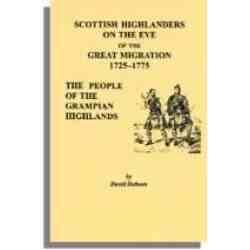In 2005 Clearfield Company launched a new series of books by David Dobson designed to identify the origins of Scottish Highlanders who traveled to America prior to the Great Highland Migration that began in the 1730s and intensified thereafter. The first five volumes cover Scottish Highlanders from Argyll, Perthshire, Inverness-shire, the Northern Highlands, and the Northern Isles. This sixth and concluding volume pertains to the Grampian Highlands.
Much of the Highland emigration was directly related to a breakdown in social and economic institutions. Under the pressures of the commercial and industrial revolutions of the 17th and 18th centuries, Highland chieftains abandoned their patriarchal role in favor of becoming capitalist landlords. By raising farm rents to the breaking point, the chiefs left the social fabric of the Scottish Highlands in tatters. Accordingly, voluntary emigration by Gaelic-speaking Highlanders began in the 1730s. The social breakdown was intensified by the failure of the Jacobite cause in 1745, followed by the British military occupation and repression in the Highlands in the aftermath of the Battle of Culloden. In 1746, the British government dispatched about 1,000 Highland Jacobite prisoners of war to the colonies as indentured servants. Later, during the Seven Years’ War of 1756–1763 (known as the French and Indian War in the North American colonies), Highland regiments recruited in the service of the British crown chose to settle in Canada and America rather than return to Scotland.
Once in North America, the Highlanders tended to be clannish and moved in extended family groups, unlike immigrants from the Lowlands who moved as individuals or in groups of a few families. The Gaelic-speaking Highlanders tended to settle on the western frontier, whereas the Lowlanders merged with the English on the coast. Highlanders seem to have established “beachheads,” and their kin subsequently followed. The best example of this pattern is in North Carolina, where they first arrived in 1739 and moved to the Piedmont, to be followed by others for more than a century.
Another factor that distinguishes research in Highland genealogy is the availability of pertinent records. Scottish genealogical research is generally based on the parish registers of the Church of Scotland, which provide information on baptisms and marriages. In the Scottish Lowlands, such records can date back to the mid-16th century, but, in general, Highland records start much later. Americans seeking their Highland roots, therefore, face the problem that there are few, if any, parish records available that pre-date the American Revolution. In the absence of Church of Scotland records, the researcher must turn to a miscellany of other records, such as court records, estate papers, sasines, gravestone inscriptions, burgess rolls, port books, services of heirs, wills and testaments, and especially rent rolls. (Some rent rolls even pre-date parish registers.) This series, therefore, is designed to identify the kinds of records that are available in the absence of parish registers and to supplement those registers when they are available.
The Grampian Highlands stretch from the Braes of Angus in the south, north-eastwards following a geological fault line known as the Highland Line to Aberdeenshire, then west as far as Strathspey. The region embraces the mountainous areas of Angus, Kincardineshire, Aberdeenshire, Banffshire, and Morayshire but does not include the fertile coastal plain nor Strathmore. The main clans associated with the Grampian Highlands were Davidson, Farquharson, Forbes, Gordon, Grant, Keith, Lindsay, Mackintosh, MacPherson, and Ogilvie. As northeast Scotland tended to be a stronghold of Jacobitism, many of its supporters from the Grampian Highlands were transported to America and the West Indies after 1715 and 1745. In the 18th century, there were small-scale emigrations from north-east ports, such as Aberdeen, as most of emigrants chose to leave via Clyde ports (such as the Grants from Strathspey, who left Greenock bound for New York on the George in 1774). From the late 18th century, the rise of the transatlantic timber trade enabled many from northeastern Scotland to emigrate via Aberdeen to the Canadian maritimes.
While the present volume is not a comprehensive directory of all of the Grampian Highlanders, it does pull together references on 1,500 18th-century inhabitants from that region. In all cases, Mr. Dobson gives each Highlander’s name, a locality within the Northern Isles (place of birth, residence, employment, etc.), a date, and the source. In some cases, we also learn the identities of relatives, the individual’s employment, vessel traveled on, and so forth.


